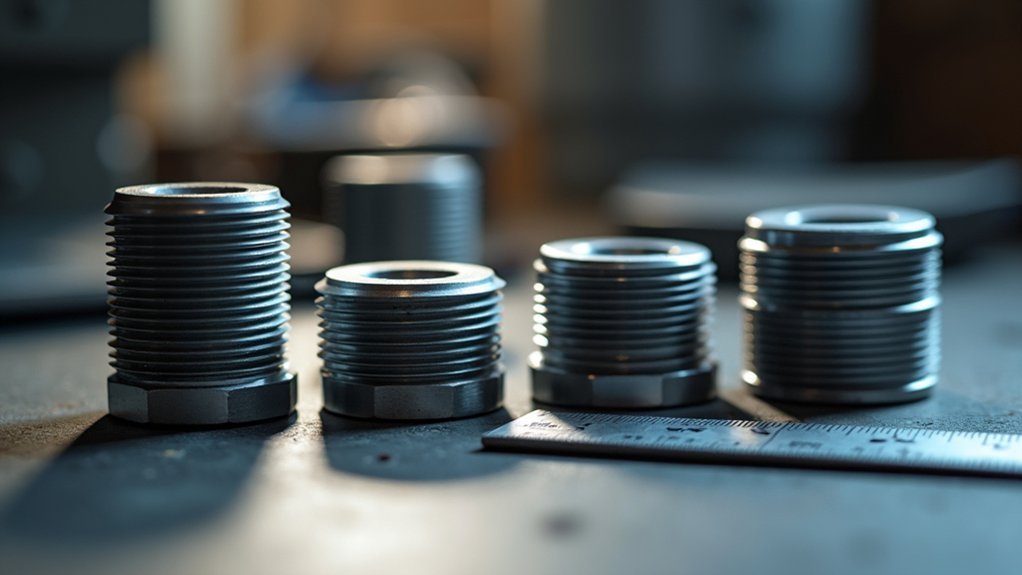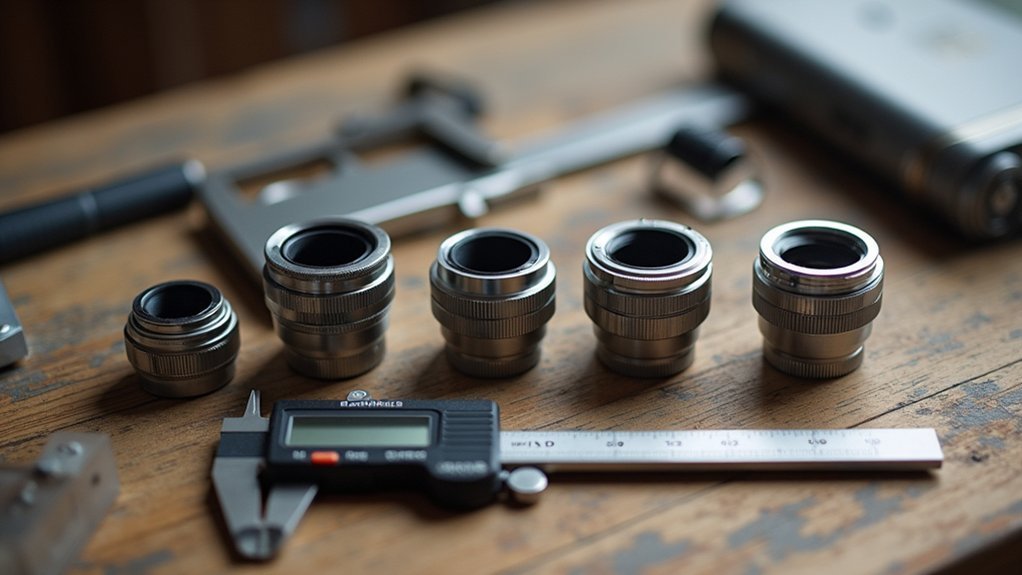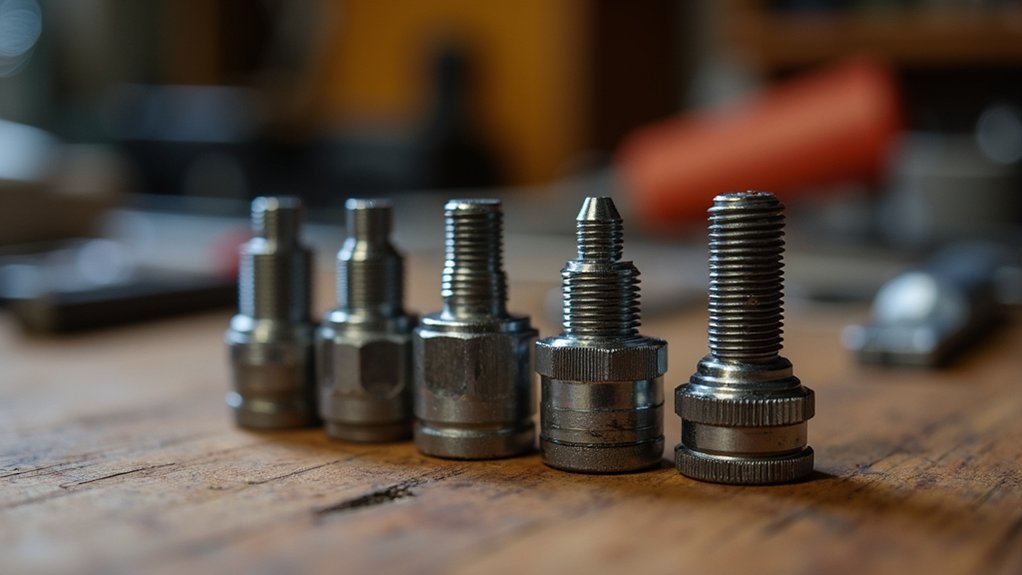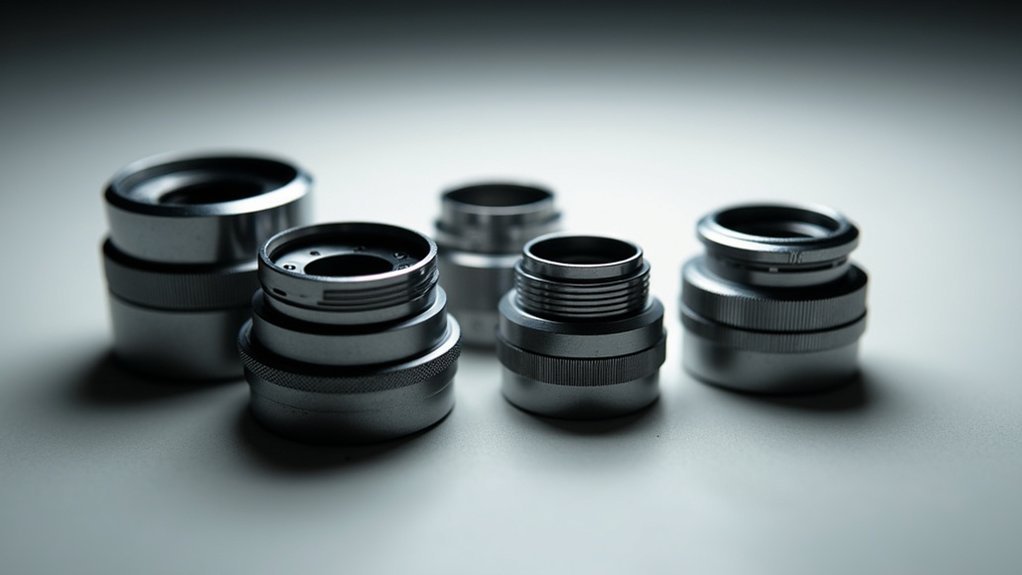To measure camera thread sizes accurately, you’ll need a digital caliper and thread gauge. Zero your caliper before measuring the outer diameter of external threads or inner diameter of internal threads. For metric threads (like M42x0.75), measure in millimeters; for imperial (like 1″-32 TPI), count threads per inch. Common camera adapters include M42x1.0, M25x0.5, and C-mount (1″-32 TPI). Check both diameter and pitch to prevent compatibility issues with microscope connections.
Essential Tools for Measuring Thread Pitch Accurately

Maneuvering the world of camera thread sizes requires precision and the right equipment. When identifying thread specifications, your digital caliper becomes your most valuable asset. Before measuring, always zero your caliper and make sure the jaws are clean to avoid inaccurate readings.
Thread gauges complement your digital caliper by determining the exact pitch—the distance between adjacent thread crests. For internal threads, remember to apply the formula D = d + P to calculate the external diameter.
Precision matters—always pair your caliper with a thread gauge to determine pitch before calculating external diameters.
Position your caliper jaws correctly when measuring; improper placement will yield invalid results. Regularly calibrate your tools against known standards to maintain measurement accuracy over time.
This calibration step is often overlooked but proves essential when working with the fine threads commonly found in camera equipment.
Understanding Metric vs. Imperial Thread Systems
When maneuvering camera attachments, you’ll quickly encounter the two predominant thread systems: metric and imperial.
Metric threads are identified by “M” followed by the major diameter and pitch in millimeters (like M42x0.75), while imperial threads use inches and thread count (such as 1/4-20 UNC).
The key difference lies in their measurements: metric focuses on the distance between thread peaks (pitch), while imperial counts threads per inch. This distinction is essential when determining thread size compatibility between equipment.
In photography, you’ll commonly find metric pitches ranging from 0.5mm to 1.5mm, while the standard imperial tripod threads are 1/4-20 UNC and 3/8-16 UNC.
Never force incompatible threads together—even similarly sized threads with different pitches won’t mate properly and could damage your equipment.
Step-by-Step Thread Identification Process

How can you accurately identify the thread specifications on your camera equipment? Begin with your digital caliper to measure the outer diameter of external threads. Make sure the caliper is zeroed and clean before taking readings for maximum accuracy.
Next, determine the thread pitch using a thread gauge, which reveals the distance between adjacent thread crests. For internal threads, measure the inner diameter and use the formula D = d + P to calculate the compatible external diameter needed.
Always verify your measurements against standard photography thread sizes, like the common 1/4 inch 20 UNC or 3/8 inch 16 UNC.
Document both the major diameter and pitch thoroughly to prevent future compatibility issues when purchasing accessories or adapters for your equipment.
Common Camera-to-Microscope Adapter Specifications
Three essential thread specifications dominate the camera-to-microscope adapter market.
When connecting your camera to a microscope, you’ll need to match the appropriate thread sizes between both devices to guarantee perfect alignment and ideal imaging results.
- M42x1.0 threads – Standard for many camera mounts, providing a secure connection between adapter and camera body.
- M25x0.5 threads – Common for microscope eyepiece connections, requiring precise measurement of eyepiece diameter.
- C-mount adapters – Feature 1″-32TPI threads widely used in scientific imaging systems.
- T-mount adapters – Utilize M42x0.75 threads that connect to various camera brands with appropriate rings.
Always measure both the outer diameter of your microscope eyepiece and the inner diameter of your camera mounts to confirm compatibility before purchasing adapters.
The right fit prevents light leakage and guarantees proper optical alignment.
Troubleshooting Mismatched Thread Connections

Despite careful planning, you’ll occasionally encounter frustrating thread mismatches when connecting cameras to microscopes or attaching filters to lenses.
When this happens, first verify both inner and outer diameters using a digital caliper to identify any mismatched measurements that might be causing the issue.
Don’t overlook thread pitch—even identically sized diameters can have incompatible threading patterns. Use a thread gauge to confirm the exact specifications before attempting connections.
For size discrepancies, consider step-up or step-down rings as intermediate adapters.
Before purchasing additional equipment, inspect your threads for debris or damage that might prevent proper fitting.
If problems persist, consult your equipment’s user manual or contact the manufacturer directly.
Sometimes the solution is as simple as identifying the correct thread specification for your specific model.
Frequently Asked Questions
How Do You Measure a Thread Adapter?
To measure a thread adapter, you’ll need to use a digital caliper for the outer and inner diameters, then employ a thread gauge for pitch measurement. Always clean the caliper jaws for accuracy.
How Do I Know What Size Thread I Have?
You’ll know your thread size by measuring the outer diameter with a digital caliper and determining the pitch with a thread gauge. For camera threads, it’s typically 1/4″ 20 UNC or 3/8″ 16 UNC.
What Size Are the Threads on a Camera?
Your camera’s threads are typically 1/4″-20 UNC for tripod mounts, while lens filter threads vary by model (often 49mm-77mm). You’ll find larger equipment using 3/8″-16 UNC. Check your manual for specific sizes.
What Is the Diameter of M14X1 5 Thread?
The diameter of an M14x1.5 thread is 14mm. You’ll find this measurement refers to the major (outer) diameter of the thread. The 1.5 represents the pitch—the distance between thread peaks.
In Summary
You’ve now mastered the essentials of camera thread measurement. With your thread pitch gauge and caliper, you’ll confidently distinguish between metric and imperial systems. Remember, proper identification prevents costly adapter mistakes. When connecting cameras to microscopes, always double-check specifications before purchasing. If you encounter resistance, don’t force it—revisit your measurements or consider a step-up/step-down adapter. Your imaging equipment deserves the perfect connection.





Leave a Reply